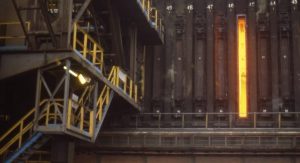
Most steel is made using one of two processes. The first is an Electric Arc Furnace (EAF), which uses scrap steel as the main feedstock. The scrap is charged into the furnace, where huge electrodes create an arc of electricity that melts the charge so it can then be refined and processed into the desired alloy. The second process is an integrated mill, where Blast Furnaces supply liquid iron to a Basic Oxygen Furnace (BOF). Blast Furnaces primarily use coke, iron ore, and limestone as feedstock.
Worldwide, the Blast Furnace/Basic Oxygen Furnace (BF/BOF) process accounts for 3/4 of all steel produced, while in the U.S.A. this process only accounts for only about a third of steelmaking capacity. The majority of steel made in the U.S. is produced using EAFs, due to the economies they provide. Nevertheless, integrated mills won’t disappear any time soon, so it’s important to understand where hoses work…and where they can fail.
Before Coke, There Was Coal
In an integrated steel mill, liquid iron is the precursor of refined steel. Liquid iron is made in a blast furnace, using iron ore, limestone, and coke. This coke is produced using a special grade of coal called metallurgical coal, or coking coal. Metallurgical coal is usually a blend of coal from various sources, in order to achieve the correct content of energy, ash, and moisture. This coal is then conditioned and put into coke ovens, where multiple ovens are typically positioned side-by-side, forming a coke oven battery. The coal is then heated without consuming it completely by controlling the air intake. This converts the coal into hard, porous, carbon-rich coke.
The doors to the coke ovens, the dampers controlling air intake, and the mechanism that pushes the coke out of the oven are typically operated using hydraulics, and if the hot coke falls onto a rubber or thermoplastic hydraulic hose, bad things can happen. Corrugated metal hydraulic hoses are great for this application, as they resist the effects of orange-hot coke, and provide the best combination of high working pressures and great flexibility, all at a great value.
Quench Your Thirst
Once this coke is ready for use, it is pushed out of the coke oven and taken to a quenching tower for cooling. Special rail cars called quench cars are used to take the hot coke to the quench tower, where it is cooled using water or an inert gas, such as nitrogen. The cooled coke is then released from the quench car using hydraulically actuated dumping mechanisms, where hose damage can occur if hot coke drops onto the hydraulic hoses. Some systems use mechanical conveying systems to transfer the coke to the quenching mechanism, and high ambient heat conditions may be present here as well. Metal hoses provide rugged resistance to these extreme operating environments.
When It's Hot
Moving on to the steelmaking side of things, there are many more applications where metal hoses outperform non-metallic options, from the conversion furnaces to the casters to hot strip mills. Whether conveying water, steam, or hydraulic fluid, corrugated metal hose provides long-lasting, worry-free service in hot, corrosive conditions. Metal hoses do not suffer from cracking or blistered covers like rubber hoses can, and don’t have any permeation issues. Metal hose assemblies feature a welded construction, providing fire resistance and positive fitting retention. External covers can be added to protect metal hose from molten splash. Insulating sleeves can be used to protect the media being conveyed from high ambient heat radiating from newly-cast steel. Metal expansion joints can replace cooling hoses on the EAF roof, reducing failures and leaks. High-pressure hoses like our PressureMax HP are great for hydraulic electrode clamping systems, pinch rolls, and descaling hoses. The list goes on and on.
Hose Master is the industry expert in solving the toughest applications in the harshest environments. We can help you identify problems in the field, but we don’t stop there. Our application expertise, engineering assistance, and expansive product line maximize service life, reliability, and safety. When the heat is on, let Hose Master help you by providing the best products with unbeatable service. Give us a call today.
The original article was written by Frank Caprio, Corporate Trainer - Major Market Specialist at Hose Master.
For more information about metal hose products or to see which metal hose may be a good fit for your application, please contact Gallagher Fluid Seals today.
